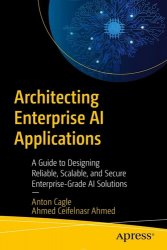 Название
Название: Architecting Enterprise AI Applications: A Guide to Designing Reliable, Scalable, and Secure Enterprise-Grade AI Solutions
Автор: Anton Cagle, Ahmed Ceifelnasr Ahmed
Издательство: Apress
Год: 2024
Страниц: 282
Язык: английский
Формат: pdf
Размер: 36.1 MB
This book explores how to define, design, and maintain enterprise AI applications, exploring the impacts they will have on the teams who work with them. The book is structured into four parts. In Part 1: Defining Your AI Application, you are introduced to the dynamic interplay between human adaptability and AI specialization, the concept of meta systems, and the mechanics of prediction machines. In Part 2: Designing Your AI Application, the book delves into the anatomy of an AI application, unraveling the intricate relationships among data, Machine Learning, and reasoners. This section introduces the building blocks and enterprise architectural framework for designing multi-agent systems. Part 3: Maintaining Your AI Application takes a closer look at the ongoing life cycle of AI systems. You are guided through the crucial aspects of testing and test automation, providing a solid foundation for effective development practices. This section covers the critical tasks of security and information curation that ensure the long-term success of enterprise AI applications. The concluding section, Part 4: AI Enabled Teams, navigates the evolving landscape of collaborative efforts between humans and AI. It explores the impact of AI on remote work dynamics and introduces the new roles of the expert persona and the AI handler. This section concludes with a deep dive into the legal and ethical dimensions that AI-enabled teams must navigate.










